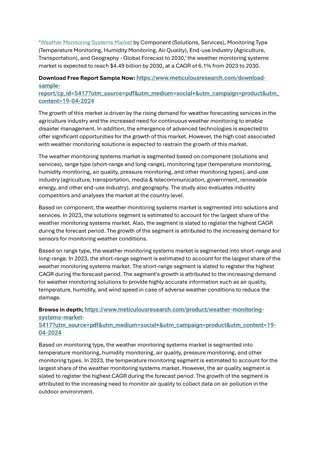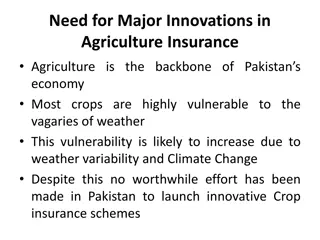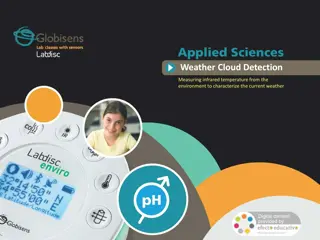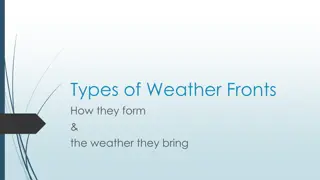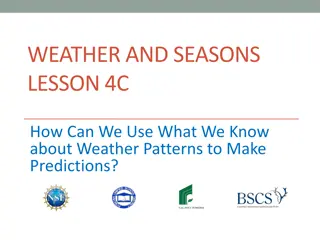Strategies for Crop Planning in Aberrant Weather Conditions
Delve into the challenges of aberrant weather in rainfed areas, exploring soil and climatic conditions, water harvesting techniques, and contingency crop planning. Discover the impact of erratic rainfall patterns on crop growth and learn about midseason corrections to mitigate adverse effects. Explore the concept of contingency cropping as a strategy to adapt to uncertain weather conditions and optimize agricultural yields.
Download Presentation

Please find below an Image/Link to download the presentation.
The content on the website is provided AS IS for your information and personal use only. It may not be sold, licensed, or shared on other websites without obtaining consent from the author.If you encounter any issues during the download, it is possible that the publisher has removed the file from their server.
You are allowed to download the files provided on this website for personal or commercial use, subject to the condition that they are used lawfully. All files are the property of their respective owners.
The content on the website is provided AS IS for your information and personal use only. It may not be sold, licensed, or shared on other websites without obtaining consent from the author.
E N D
Presentation Transcript
Contingent crop planning for aberrant weather conditions Delivered by Mr. Anil Swami Asst. Professor 1 Mr. Anil Swami Mr. Anil Swami Rainfed Agriculture & Watershed Management Rainfed Agriculture & Watershed Management
Objective:- Tell the soil and climatic conditions prevalent in rainfed areas. Interpret various water harvesting techniques and their efficient utilization. Apply contingent crop planning for aberrant weather conditions. Examine the seasonal rainfall and different types of watershed and its components. Select soil and water conservation techniques to avoid their losses. 2 Mr. Anil Swami Rainfed Agriculture & Watershed Management
Contingent crop planning for aberrant weather conditions Rainfall behavior in dry farming areas is erratic and uncertain. The deviations in rainfall behavior include delayed onset, early withdrawal and intermediary dry spells during rainy season. The adverse effect of these rainfall aberrations on crop growth vary with the degree of deviation and the crop growth stage at which such deviations occur. Mr. Anil Swami Rainfed Agriculture & Watershed Management
Suitable manipulations in crop management practices are needed to minimize such adverse effects of abnormal rainfall behavior. These management decisions constitute contingency planning. Such management practices done after crop establishment and in the middle of growth are called midseason or midterm corrections. Mr. Anil Swami Rainfed Agriculture & Watershed Management
Mr. Anil Swami Rainfed Agriculture & Watershed Management
CONTINGENCY CROPPING Contingency cropping is growing of a suitable crop in place of normally sown highly profitable crop of the region due to aberrant weather conditions. In dryland agriculture, contingency of growing another crop in place of normally grown crop arises due to delay in the onset of monsoon. Depending upon the date of receipt of rainfall, crops are selected. Mr. Anil Swami Rainfed Agriculture & Watershed Management
It is assumed that the rainfall for the subsequent period is normal and depending upon the economic status of the farmer, certain amount of risk is taken to get good profits if season is normal or better than normal. Contingency cropping is highly location specific due to variation in amount and distribution of rainfall. Especially in arid regions, the spatial distribution of rainfall is highly variable. It is common to observe that rainfall received varies from field to field in the same location. Temperature gradually falls from August onwards reaching minimum in November and December. Mr. Anil Swami Rainfed Agriculture & Watershed Management
Contingency plan and midterm corrections vary with the type and time of occurrence of rainfall aberration. Crops have to be selected with suitable crop duration to coincide with the length of the growing season. Generally short duration pulses like greengram, black gram and cowpea may suit the situation. However if the monsoon turns to be extraordinarily good, opportunity is lost if only short duration crops are sown. Mr. Anil Swami Rainfed Agriculture & Watershed Management
Farmers with economic strength and motivation for high profits with some amount of risk can go for crops of long duration. The long duration crops with flexibility or elasticity in yield are more suitable. For example, pearl millet, and sorghum can be ratooned if monsoon extends. Sunflower can be introduced for higher profits with certain amount of risk. Crops like sorghum, pearl millet, can be grown for grain if monsoon extends and if not, fodder can be obtained. Mr. Anil Swami Rainfed Agriculture & Watershed Management
Mr. Anil Swami Rainfed Agriculture & Watershed Management
Mr. Anil Swami Rainfed Agriculture & Watershed Management
Crop planning for successful crop production under water scarcity and dry farming condition: In low rainfall and water scarcity situations during kharif, the crops like Bajra, Castor and legumes crop like Tur, Moong, Black gram, Kidney bean, Guar and Cowpea. Mr. Anil Swami Rainfed Agriculture & Watershed Management
Crop planning for successful crop production under water scarcity and dry farming condition should be as under: 1. Bunding and leveling should be done to conserve the rain water in situ. 2. Sowing the crop at optimum time. 3. Tillage and sowing of the crop across the slope. 4. Use higher amount of organic manures like FYM, compost, vermicompost and cake. Mr. Anil Swami Rainfed Agriculture & Watershed Management
5. Apply fertilizers at sowing under adequate soil moisture or as top dressing after irrigation. 6. Use drip irrigation in wide spaced crops and sprinkler irrigation in narrow spaced crops, if possible. 7. Inter culturing, weeding and crop protection measures should be done as and when required. 8. Adopt mixed and inter cropping systems. 9. Raise crop in strip cropping. 10. Create farm pond for life saving irrigation. Mr. Anil Swami Rainfed Agriculture & Watershed Management
Mr. Anil Swami Rainfed Agriculture & Watershed Management
Mr. Anil Swami Rainfed Agriculture & Watershed Management
3. Recommendation for late onset of monsoon Generally, the period between 15th June to 15th September is considered as kharif season. However, it is required to change the crop planning in kharif season, if the rainfall pattern is found uneven. If there is a late onset of monsoon, then select the crops and their verities as under: Mr. Anil Swami Rainfed Agriculture & Watershed Management
1. Onset of monsoon in the first week of July- Groundnut varieties Gujarat Groundnut 2, Gujarat Groundnut 5 and Gujarat Groundnut 7 as well as cowpea variety Gujarat 1should be grown. 2. If sufficient rainfall occurs during first fortnight of July - Crops like bajra, moong, black gram, sesame, castor and tur should be grown. 3. If sufficient rainfall occurs at the end of July Sesame (Purva 1) and forage sorghum variety Gundari should be grown. Mr. Anil Swami Rainfed Agriculture & Watershed Management
Mr. Anil Swami Rainfed Agriculture & Watershed Management
5. Recommendations under long dry spell There is a shortage of moisture in the soil, if the duration between two rainfall is extended even under normal on set on monsoon. If this period between rainfall is extended for longer time, than there is a partial or full failure of the crop. Mr. Anil Swami Rainfed Agriculture & Watershed Management
Under this situation crop planning should be done as under 1. Do interculturing and weeding. Keep crop weed free and do mulching. 2. When moisture stress prevails, thinning should be done. If more moisture stress prevails, remove alternate row and thin the plant in the field 3. Provide lifesaving irrigation to the crop if irrigation facility available 4. When sufficient rainfall received after dry spell, nitrogen fertilizer should be given as top dress to the crops except groundnut. Mr. Anil Swami Rainfed Agriculture & Watershed Management
5. When crop failed due to long dry spell, after receiving sufficient rainfall farmers can grow hybrid pearl millet GHB 558, GHB 577. 6. Farmers should grow Sesame variety Purva 1 or Gujarat Til 1 or Castor variety GAUCH 1 and GAC 11. In addition farmers can also grow fodder sorghum or rajaka bajri. 7. Reduce the plants by harvesting the matured plants frequently, to save the conserved Mr. Anil Swami Rainfed Agriculture & Watershed Management
6. Recommendations when heavy rainfall occurs at the end of monsoon during August September Many times during end of September or beginning of October late rainfall received. Under such situation following crop planning can be done. 1. For getting the benefits of good late rainfall sowing of fodder sorghum, short duration semi rabi and rabi crops i.e. castor, mustard, gram, safflower, fodder crops (maize/oat and lucerne) should be grown as relay crops between two rows of long duration crops i.e. cotton, tur and fennel. 2. Gram, mustard and fodder sorghum can be grown after harvesting of early maturing Kharif crops. Mr. Anil Swami Rainfed Agriculture & Watershed Management
24 Mr. Anil Swami Mr. Anil Swami Rainfed Agriculture & Watershed Management Rainfed Agriculture & Watershed Management



